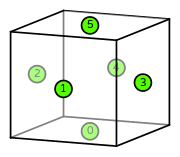an encyclopedia of finite element definitions
Degree 1 Crouzeix–Raviart on a hexahedron
◀ Back to Crouzeix–Raviart definition page
- \(R\) is the reference hexahedron. The following numbering of the subentities of the reference cell is used:
- \(\mathcal{V}\) is spanned by: \(1\), \(x\), \(y\), \(z\), \(x^{2} - y^{2}\), \(y^{2} - z^{2}\)
- \(\mathcal{L}=\{l_0,...,l_{5}\}\)
- Functionals and basis functions:

\(\displaystyle l_{0}:v\mapsto v(\tfrac{1}{2},\tfrac{1}{2},0)\)
\(\displaystyle \phi_{0} = - \frac{2 x^{2}}{3} + \frac{2 x}{3} - \frac{2 y^{2}}{3} + \frac{2 y}{3} + \frac{4 z^{2}}{3} - \frac{7 z}{3} + \frac{2}{3}\)
This DOF is associated with face 0 of the reference cell.
\(\displaystyle \phi_{0} = - \frac{2 x^{2}}{3} + \frac{2 x}{3} - \frac{2 y^{2}}{3} + \frac{2 y}{3} + \frac{4 z^{2}}{3} - \frac{7 z}{3} + \frac{2}{3}\)
This DOF is associated with face 0 of the reference cell.
\(\displaystyle l_{1}:v\mapsto v(\tfrac{1}{2},0,\tfrac{1}{2})\)
\(\displaystyle \phi_{1} = - \frac{2 x^{2}}{3} + \frac{2 x}{3} + \frac{4 y^{2}}{3} - \frac{7 y}{3} - \frac{2 z^{2}}{3} + \frac{2 z}{3} + \frac{2}{3}\)
This DOF is associated with face 1 of the reference cell.
\(\displaystyle \phi_{1} = - \frac{2 x^{2}}{3} + \frac{2 x}{3} + \frac{4 y^{2}}{3} - \frac{7 y}{3} - \frac{2 z^{2}}{3} + \frac{2 z}{3} + \frac{2}{3}\)
This DOF is associated with face 1 of the reference cell.
\(\displaystyle l_{2}:v\mapsto v(0,\tfrac{1}{2},\tfrac{1}{2})\)
\(\displaystyle \phi_{2} = \frac{4 x^{2}}{3} - \frac{7 x}{3} - \frac{2 y^{2}}{3} + \frac{2 y}{3} - \frac{2 z^{2}}{3} + \frac{2 z}{3} + \frac{2}{3}\)
This DOF is associated with face 2 of the reference cell.
\(\displaystyle \phi_{2} = \frac{4 x^{2}}{3} - \frac{7 x}{3} - \frac{2 y^{2}}{3} + \frac{2 y}{3} - \frac{2 z^{2}}{3} + \frac{2 z}{3} + \frac{2}{3}\)
This DOF is associated with face 2 of the reference cell.
\(\displaystyle l_{3}:v\mapsto v(1,\tfrac{1}{2},\tfrac{1}{2})\)
\(\displaystyle \phi_{3} = \frac{4 x^{2}}{3} - \frac{x}{3} - \frac{2 y^{2}}{3} + \frac{2 y}{3} - \frac{2 z^{2}}{3} + \frac{2 z}{3} - \frac{1}{3}\)
This DOF is associated with face 3 of the reference cell.
\(\displaystyle \phi_{3} = \frac{4 x^{2}}{3} - \frac{x}{3} - \frac{2 y^{2}}{3} + \frac{2 y}{3} - \frac{2 z^{2}}{3} + \frac{2 z}{3} - \frac{1}{3}\)
This DOF is associated with face 3 of the reference cell.
\(\displaystyle l_{4}:v\mapsto v(\tfrac{1}{2},1,\tfrac{1}{2})\)
\(\displaystyle \phi_{4} = - \frac{2 x^{2}}{3} + \frac{2 x}{3} + \frac{4 y^{2}}{3} - \frac{y}{3} - \frac{2 z^{2}}{3} + \frac{2 z}{3} - \frac{1}{3}\)
This DOF is associated with face 4 of the reference cell.
\(\displaystyle \phi_{4} = - \frac{2 x^{2}}{3} + \frac{2 x}{3} + \frac{4 y^{2}}{3} - \frac{y}{3} - \frac{2 z^{2}}{3} + \frac{2 z}{3} - \frac{1}{3}\)
This DOF is associated with face 4 of the reference cell.
\(\displaystyle l_{5}:v\mapsto v(\tfrac{1}{2},\tfrac{1}{2},1)\)
\(\displaystyle \phi_{5} = - \frac{2 x^{2}}{3} + \frac{2 x}{3} - \frac{2 y^{2}}{3} + \frac{2 y}{3} + \frac{4 z^{2}}{3} - \frac{z}{3} - \frac{1}{3}\)
This DOF is associated with face 5 of the reference cell.
\(\displaystyle \phi_{5} = - \frac{2 x^{2}}{3} + \frac{2 x}{3} - \frac{2 y^{2}}{3} + \frac{2 y}{3} + \frac{4 z^{2}}{3} - \frac{z}{3} - \frac{1}{3}\)
This DOF is associated with face 5 of the reference cell.